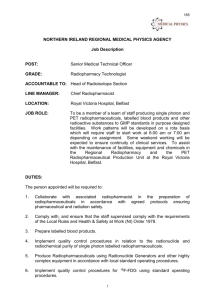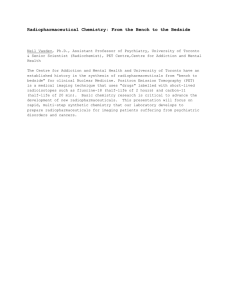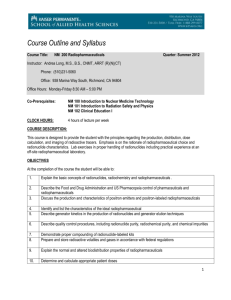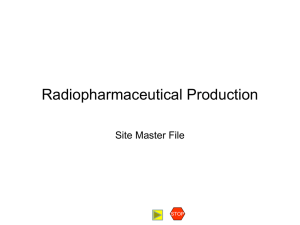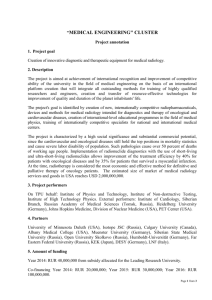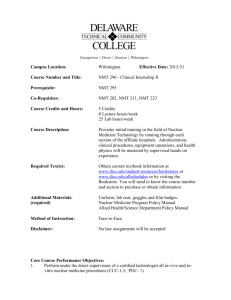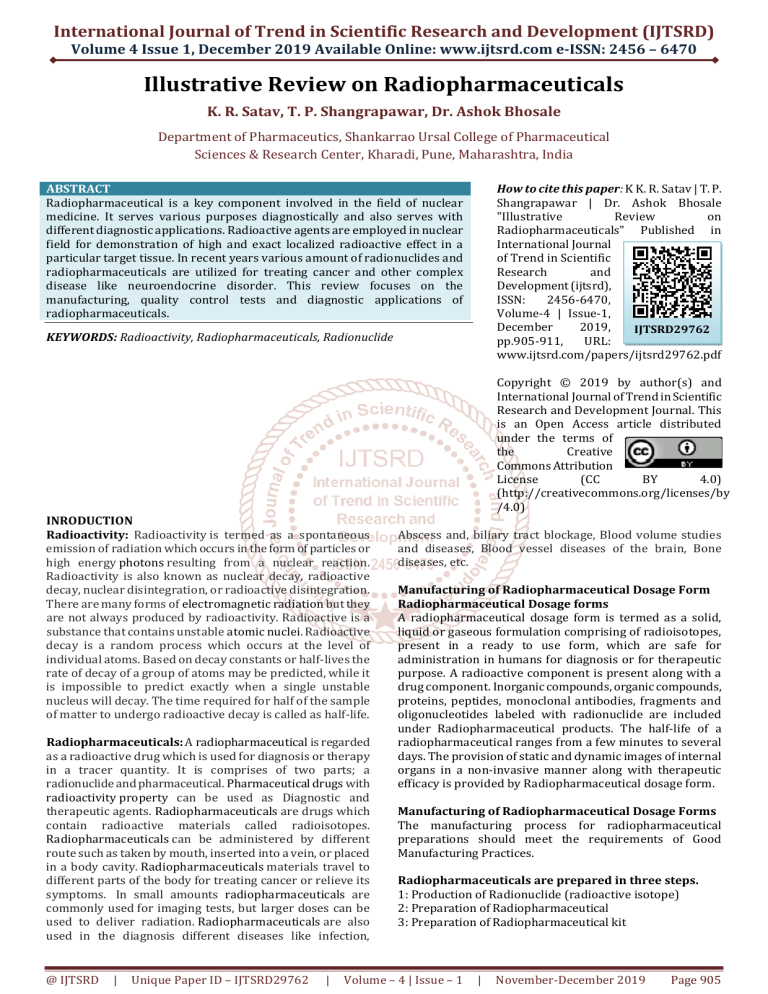
International Journal of Trend in Scientific Research and Development (IJTSRD) Volume 4 Issue 1, December 2019 Available Online: www.ijtsrd.com e-ISSN: 2456 – 6470 Illustrative Review on Radiopharmaceuticals K. R. Satav, T. P. Shangrapawar, Dr. Ashok Bhosale Department of Pharmaceutics, Shankarrao Ursal College of Pharmaceutical Sciences & Research Center, Kharadi, Pune, Maharashtra, India How to cite this paper: K K. R. Satav | T. P. Shangrapawar | Dr. Ashok Bhosale "Illustrative Review on Radiopharmaceuticals" Published in International Journal of Trend in Scientific Research and Development (ijtsrd), ISSN: 2456-6470, Volume-4 | Issue-1, December 2019, IJTSRD29762 pp.905-911, URL: www.ijtsrd.com/papers/ijtsrd29762.pdf ABSTRACT Radiopharmaceutical is a key component involved in the field of nuclear medicine. It serves various purposes diagnostically and also serves with different diagnostic applications. Radioactive agents are employed in nuclear field for demonstration of high and exact localized radioactive effect in a particular target tissue. In recent years various amount of radionuclides and radiopharmaceuticals are utilized for treating cancer and other complex disease like neuroendocrine disorder. This review focuses on the manufacturing, quality control tests and diagnostic applications of radiopharmaceuticals. KEYWORDS: Radioactivity, Radiopharmaceuticals, Radionuclide Copyright © 2019 by author(s) and International Journal of Trend in Scientific Research and Development Journal. This is an Open Access article distributed under the terms of the Creative Commons Attribution License (CC BY 4.0) (http://creativecommons.org/licenses/by /4.0) INRODUCTION Radioactivity: Radioactivity is termed as a spontaneous emission of radiation which occurs in the form of particles or high energy photons resulting from a nuclear reaction. Radioactivity is also known as nuclear decay, radioactive decay, nuclear disintegration, or radioactive disintegration. There are many forms of electromagnetic radiation but they are not always produced by radioactivity. Radioactive is a substance that contains unstable atomic nuclei. Radioactive decay is a random process which occurs at the level of individual atoms. Based on decay constants or half-lives the rate of decay of a group of atoms may be predicted, while it is impossible to predict exactly when a single unstable nucleus will decay. The time required for half of the sample of matter to undergo radioactive decay is called as half-life. Radiopharmaceuticals: A radiopharmaceutical is regarded as a radioactive drug which is used for diagnosis or therapy in a tracer quantity. It is comprises of two parts; a radionuclide and pharmaceutical. Pharmaceutical drugs with radioactivity property can be used as Diagnostic and therapeutic agents. Radiopharmaceuticals are drugs which contain radioactive materials called radioisotopes. Radiopharmaceuticals can be administered by different route such as taken by mouth, inserted into a vein, or placed in a body cavity. Radiopharmaceuticals materials travel to different parts of the body for treating cancer or relieve its symptoms. In small amounts radiopharmaceuticals are commonly used for imaging tests, but larger doses can be used to deliver radiation. Radiopharmaceuticals are also used in the diagnosis different diseases like infection, @ IJTSRD | Unique Paper ID – IJTSRD29762 | Abscess and, biliary tract blockage, Blood volume studies and diseases, Blood vessel diseases of the brain, Bone diseases, etc. Manufacturing of Radiopharmaceutical Dosage Form Radiopharmaceutical Dosage forms A radiopharmaceutical dosage form is termed as a solid, liquid or gaseous formulation comprising of radioisotopes, present in a ready to use form, which are safe for administration in humans for diagnosis or for therapeutic purpose. A radioactive component is present along with a drug component. Inorganic compounds, organic compounds, proteins, peptides, monoclonal antibodies, fragments and oligonucleotides labeled with radionuclide are included under Radiopharmaceutical products. The half-life of a radiopharmaceutical ranges from a few minutes to several days. The provision of static and dynamic images of internal organs in a non-invasive manner along with therapeutic efficacy is provided by Radiopharmaceutical dosage form. Manufacturing of Radiopharmaceutical Dosage Forms The manufacturing process for radiopharmaceutical preparations should meet the requirements of Good Manufacturing Practices. Radiopharmaceuticals are prepared in three steps. 1: Production of Radionuclide (radioactive isotope) 2: Preparation of Radiopharmaceutical 3: Preparation of Radiopharmaceutical kit Volume – 4 | Issue – 1 | November-December 2019 Page 905 International Journal of Trend in Scientific Research and Development (IJTSRD) @ www.ijtsrd.com eISSN: 2456-6470 Step 1 Production of Radionuclide Nuclear Neutron Fission Cyclotron bombardment method Formation of Radionuclide (Can be used in either elemental or salt form as ready to use radiopharmaceutical 1. Production of Radionuclide (radioactive isotopes) Artificial production of Radionuclides by the process of nuclear activation in a nuclear reactor. In such a reactor stable atoms are bombarded with excess neutrons. The resulting addition of neutron to stable atoms produces radionuclide. Methods of producing radionuclide are as follows: A. Nuclear fission B. Neutron reactions C. Cyclotron method A. Nuclear fission Nuclear Fission is termed as a radioactive process in which a heavy nucleus split into two new nuclei of almost equal size with simultaneous emission of two or three neutrons. @ IJTSRD | Unique Paper ID – IJTSRD29762 | Fission is induced by bombardment of the parent nucleus with a neutron. 235 U + 1 n X+Y+2.5n 92 0 X and Y are the radioactive isotopes formed. For each neutron consumed, an average of 2.5 new neutrons are produced that may initiate the fission of other nuclei. Such a reaction is called chain reaction. 238 U + 1 n 131 Sn + 106 Mo + 1 n + 1 n 92 0 52 42 0 0 Sn (Tin) and Mo (Molybdenum) are radioactive and decay further emitting beta particles. 131 Sn 131 sb 131 131 I 50 51 52 Te + 53 I-131 (Iodine-131) is used for medical applications. In this process, separation of the desired radioactive element from the mixture is difficult and costly. Volume – 4 | Issue – 1 | November-December 2019 Page 906 International Journal of Trend in Scientific Research and Development (IJTSRD) @ www.ijtsrd.com eISSN: 2456-6470 B. Neutron Reactions (Neutron Bombardment) The preparation of radionuclide is done by neutron activation or through transmutation reactions. An acceptable target material is bombarded by neutrons in a nuclear reactor. Radioactive phosphorous can be made by transmutation. 32 S + 1 n 32 1 16 0 15 P + 1P The radioactive phosphorous can be separated by chemical process. C. Cyclotron Method (Charged Particle Bombardment) The cyclotron or particle accelerators can be used only with charged particles like electrons, protons and alpha particles, as operation of the machine is depend upon the interaction of magnetic or electrostatic fields with the charge of the particle which is undergoing acceleration. Particles when accelerated to a very high velocity, they are caused to strike a target comprising of the atoms to be bombarded. 2. Preparation of Radiopharmaceutical Radiopharmaceuticals are prepared by following two methods, A. Radionuclide Generator B. Radiolabel ling Method A. Radionuclide Generators It is advantageous to use a nuclide with short half-life to minimize the radiation dose received by the patient, when radioactive isotopes are to be used clinically. Greater problems of supply are caused due to shorter half-life so, radionuclide generator is used. It provides a mechanism for separating a clinically useful, short half-life daughter from a long-lived parent nuclide which is used later for the production of radiopharmaceutical dosage form. e.g.: Molybdenum 99/Technetium 99m generator: It consists of an alumina column on which Molybdenum 99 is adsorbed as Ammonium molybdate. B. Radiolabel ling method Some radionuclide can be used in their elemental or salt form for medical or pharmaceutical purpose. However, most radionuclide must be incorporated into some molecule or compound to form a useful radiotracer or radiopharmaceutical by a process known as radiolabel ling. Carrier addition permits ready handling of the radiopharmaceutical. In some conditions it will be important to add carrier to enhance chemical, physical or biological properties of the radiopharmaceutical preparation. The carrier may be in the form of inactive material, either isotopic with the radionuclide, or non-isotopic, but chemically similar to the radionuclide. Radiolabel ling is done by the following methods I. Introduction of a foreign label: A radioactive isotope is chelated with other compounds to use it medically. II. Isotope exchange: Radioactive isotope is substituted for a stable atom of the same element that is already a natural part of the molecule. III. Labelling with bifunctional chelates: A bifunctional chelate is a molecule used to link another molecule with a radionuclide. @ IJTSRD | Unique Paper ID – IJTSRD29762 | IV. Biosynthesis: A radionuclide is incorporated into a molecule through some biosynthetic process. 3. Preparation of Radiopharmaceutical Kit A radiopharmaceutical kit permits the radio pharmacist for transforming the radioactive isotope obtained from the generator into the desired radiopharmaceutical. It is a vial containing freeze dried and sterile non-radioactive components into which the appropriate radionuclide is added or in which the appropriate radionuclide is diluted before medical use. The nonradioactive ingredients of a normal formulation are ligands, reducing agents, stabilizers, buffers and antioxidants. The freeze dried kit is reconstituted through aseptic transfer of the necessary close of the radioactive isotope using a sterile syringe or needle. The amount of activity withdrawn for the reconstitution of the kit is depends on the number of patient doses to be manufactured. The reconstituted kit is aseptically divided to provide each patient a dose with sufficient activity. Radiopharmaceutical preparations obtain from kits are normally intended for use within 12 hours of preparation. The radiopharmaceutical kit consist of Methylene diphosphonate: a ligand forming a complex with Technetium. Stannous ions (Stannous chloride or fluoride): a reducing agent which enhances the complication of ligand with Technetium. Other compounds such as stabilizers, buffers and antioxidants. Technetium complex obtained from the radiopharmaceutical kit after reconstitution should be used within 8 hours after production. Radiopharmaceutical Preparations Following are some radiopharmaceutical preparations used for diagnostic and therapeutic purpose. 1. Cobalt 57 (Co-57) and Cobalt 60 (Co-60) Cobalt in cyanocobalamine (Vitamin B12) is replaced either by radioactive cobalt 57 or cobalt 60. They are available as capsules and injection. Cobalt- 57 may be prepared by irradiating Nickel 58 (Ni-58) with gamma rays or by bombarding Iron 56 (Fe-56) with protons. Its half-life is 270 days. Cobalt- 60 is prepared by bombarding stable Cobalt 59 by a neutron. Its half-life is 5.27 years. It emits both beta and gamma particles. Cyanocobalamine Co-57 or Co-60 is used in diagnosis of pernicious anemia. Cobalt 60 is converted into needles, wires or seeds and implanted in the body cavity or directly into tumor. It is used in the treatment of the advanced stages of cancer of cervix and vagina. 2. Iodine 125 (l-125) and iodine 131(l-131) They are available as capsules, solutions and injection. Iodine 131 emits both beta and gamma radiations. Its halflife is 8.08 days it is obtained as a by-product of Uranium fission. It can also be prepared by bombarding Tellurium 130 by neutrons is used in diagnosis of functioning of thyroid gland. The size, position of the gland and possible tumor location can be assessed. Iodine 131 is used therapeutically Volume – 4 | Issue – 1 | November-December 2019 Page 907 International Journal of Trend in Scientific Research and Development (IJTSRD) @ www.ijtsrd.com eISSN: 2456-6470 to destroy thyroid tissue in cases of thyroid carcinoma, hyperthyroidism, thyrotoxicosis and severe cardiac disease. In heart diseases like angina pectoris and congestive heart disease, it is used to induce a hypothyroid state as a means of reducing the work load on the heart. Iodinated Serum Albumin (I-l25lI-131) is used to obtain circulating blood volume. It is also used for diagnosis of pulmonary blood flow, lung and bronchial tumors. 3. Iron 59 (Fe-59) It is prepared by neutron activation of Iron 58. It emits beta and gamma radiations. Its half -life is 45 days. It is used in diagnosis of problems related to iron metabolism and RBC formation. It is administered orally as Sterile Ferrous citrate solution to study absorption of iron from gastrointestinal tract. It is given intravenously to study plasma iron clearance and incorporation of iron into erythrocytes. 4. Gold 198 (Au-198) It is available in injection form which is a sterile, colloidal suspension of metallic gold. It emits both beta and gamma particles. Its short half-life is 2.7 days. It is prepared by bombarding stable Au-197 by neutrons. It is used for scintillation scanning of liver which helps in determining the shape, position and size of the organ. It helps to assess functioning of Kupffer's cells in the liver. Therapeutically, it is used in the management of pleural effusion (accumulation of serous fluid in the pleural cavity), ascites (accumulation of serous fluid in the peritoneal cavity) and rheumatoid arthritis 5. Barium sulphate Barium sulphate is used as a radiopaque contrast medium. Radiopaque contrast media are compounds or elements of high atomic number. They hinder the passage of X-rays and are used as diagnostic aid in radiology or roentgenology. Barium sulphate is available as oral solution or as an enema. If taken by mouth, it makes the esophagus, the stomach, and/or the small intestine opaque to the X-rays so that they can be photographed. If it is given by enema, the colon and/or the small intestine can be seen and photographed by x-rays. 6. Technetium-99m Technetium is an artificial element and all of its isotopes are radioactive. It is prepared by neutron bombardment of Molybdenum 99.It emits gamma rays. Its half-life is 6 hours. It is available as sodium pertechnetate and a colloidal preparation of Technetium sulphide. Technetium 99m labelled human serum albumin is used to obtain lung scans. It is also used to measure cerebral blood flow and for scintography of the salivary glands, stomach, heart and joints. Technetium 99m glucoptate is used in assessment of kidney shape, size and position. It also identifies kidney lesions. Quality Control of Radiopharmaceuticals It includes numerous specific tests that ensure purity, potency, product identity, biological safety, and effectivity of radiopharmaceuticals. Physicochemical Tests These tests are essential for the determination of the purity and integrity of a radiopharmaceutical. Radiopharmaceuticals they contain radionuclides, therefore @ IJTSRD | Unique Paper ID – IJTSRD29762 | these tests become unique and ensure specificity for radiopharmaceuticals. Physical Characteristics It contain of the colour and state of a radiopharmaceutical. A real solution mustn't be containing any particulate matter. Any deflection from the original colour and clarity should be viewed with concern as it may replicate changes in the radiopharmaceutical which would change its biological behaviour. Colloidal or aggregate preparations should have an accurate size range of particles for a given intended purpose. pH and Ionic Strength All radiopharmaceuticals must comprise of a proper hydrogen ion concentration or pH scale for maintaining their stability and integrity. Ideal pH scale of a radiopharmaceutical should be 7.4. Due to high buffer capacity of the blood pH ranges between 2 and 9. Radiopharmaceuticals should have correct Isotonicity, Ionic strength, Osmolality so as to be appropriate for human administration. By adding a correct Acid, Alkali, or Electrolyte the right ionic strength can be achieved. Radio nuclidic Purity It can be defined as the fraction of the total radioactivity in the form of the desired radionuclide present in a radiopharmaceutical. Many times extraneous impurities are known to arise during the production of the radionuclides. Radionuclidic purity affects the absorbed radiation dose and image quality. It can be measured by use of gamma spectrometry, half-life measurement and other methods to detect extraneous nuclide Radiochemical Purity It is defined as the fraction of the total radioactivity within the desired chemical form in the radiopharmaceutical. Radiochemical impurities arise from decomposition due to the action of solvent, Presence of oxidizing or reducing agents, Change in pH scale or temperature, light and radiolysis. Absorption of radiations by tagged molecules leads to the formation of free radicals with unpaired electrons .Which in turn leads to further decomposition of other molecules. A secondary method due to radiolysis produces H2O2 or HO2 from decomposition of water (solvent) that reacts with and ultimately decomposes tagged molecules. Numerous analytical methods can be used to discover and confirm the radiochemical impurities in a given radiopharmaceutical. These methods include Precipitation, High-Performance Liquid Chromatography, Paper and Instant Thin-Layer Chromatography, Paper or Polyacrylamide Gel Electrophoresis, Gel Chromatography, etc. Chemical Purity The presence of chemical impurities before radiolabeling may lead to undesirable tagged molecules which can or may not interfere with the diagnostic test. The chemical impurities may also cause a toxic effect. Purification of radiopharmaceuticals from Chemical impurities is usually achieved by strategies of chemical separation methods such as Precipitation, Distillation, Solvent extraction, etc. Radio assay The amount of radioactivity of a radiopharmaceutical before dispensing as well as before dose of administration to Volume – 4 | Issue – 1 | November-December 2019 Page 908 International Journal of Trend in Scientific Research and Development (IJTSRD) @ www.ijtsrd.com eISSN: 2456-6470 patients must be determined. These activity determinations are accomplished by means of an isotope dose calibrator. According to the Nuclear Regulatory Commission regulations the following quality control tests should be performed at the frequencies indicated: 1. Constancy (daily) 2. Accuracy (at installation, annually, and after repairs) 3. Linearity (at installation, quarterly, and after repairs) 4. Geometry (at installation and after repairs) 1. Constancy (daily): This test indicates the reproducibility of measurements by a dose calibrator. 2. Accuracy (at installation, annually, and once repairs): The accuracy of a dose calibrator is decided by measuring the activities of minimum two long-lasting reference sources and comparing the measured activity with the expressed activity. The measured activity should consider the expressed activity within G10%. 3. Linearity (at installation, quarterly, and once repairs): The linearity test specify the dose calibrator’s capacity to measure the activity accurately over a wide range of value 4. Geometry (at installation and after repairs): Variations in sample volumes or geometric configurations of the instrumentation. Measurement of Radioactivity Radioactivity of a radiopharmaceutical is measured by putting the sample within the dose calibrator with the acceptable isotope selector setting. The reading is displayed in applicable units (curie or Becquerel) on the dial. Biological Tests This test carried out essentially to examine the sterility, Pyrogenicity and Toxicity of radiopharmaceuticals before human administration. Sterility: Sterility indicates the absence of viable microorganisms such as bacteria, fungi and yeast in a radiopharmaceutical preparation. The methods of Sterilization are Autoclaving and Membrane Filtration. Special difficulties arise, in carrying out the test for sterility for radiopharmaceutical preparations because of the short half-life of most radionuclides, small size of batches and the radiation hazards. USP 32 indicates sterility tests are performed by incubating the radiopharmaceutical sample in two different ways in order to detect bacterial and fungal contaminations: 1: For bacterial contaminations the radiopharmaceutical sample should be incubated in fluid thioglycollate medium at 30–350C for fourteen days 2: For fungal contaminations the radiopharmaceutical sample should be incubated in soybean–casein digest medium for incubation at 20–250C for fourteen days Pyrogenicity: Radiopharmaceuticals for administration must be pyrogen free. The pyrogens are both polysaccharides and proteins produced with the aid of microorganisms. They are 0.05 to 1 mm in size, soluble and warmth stable. Administration of pyrogens produces signs and symptoms of fever, malaise, chills, headache, pain in joints, leukopenia, flushing, dilation of the pupils and sweating. In order to detect apyrogenicity of radiopharmaceuticals USP Rabbit test and Limulus Amebocyte Lysate (LAL) test can be carried out. For rabbit @ IJTSRD | Unique Paper ID – IJTSRD29762 | test, three mature regular rabbits are taken whose weight not less than 1.5 kg, and their temperatures are controlled by maintaining them in a place of uniform temperature. The volume of the test sample must be an equivalent human dosage, on a weight basis, and often three to ten instances the human dosage by volume is used to achieve a greater protection factor. The ear vein of each of the three rabbits the check sample is injected. The rectal temperatures of the rabbits are measured after 1, 2, and 3 h injection ofthe test material. If the temperature is push upward in man or woman rabbits is less than 0.60C and if the sum of the temperature rises in all three rabbits is not more than 1.40 C, then the check sample is considered apyrogenic. If any of the above conditions is not fulfilled, the test must be repeated with five more rabbits. If not more than three of the total eight rabbits show a temperature rise of 0.60 C and if the sum of the man or woman temperature rises does not exceed 3.70 C, the material is taken into consideration pyrogen free. A rapid method for bacterial endotoxin test, also called the LAL test, is used for the detection and quantitation of endotoxin-type pyrogens. This method uses the lysate of Amebocyte from the blood of the horseshoe crab, Limulus Polyphemus. The principle of the test is based on the formation of an opaque gel by pyrogens in the presence of Ca2+ upon incubating the sample with the LAL at 370C. An assay mixture usually includes of 0.1 mL LAL and a test sample at pH 6–8. The reaction takes place within 15–60 min after mixing and depends on the concentration of pyrogens. The formation of a gel shows the presence of pyrogens. The LAL test is carried out on unknown samples as well as on E. coli endotoxin and water samples. Usually 0.1 mL of every sample and LAL are incubated at 370C for 60 min. If the E. coli endotoxin sample shows gel formation (positive control) and the water sample shows no gel formation (negative control), then unknown samples are taken into consideration positive or negative depending on whether they form gel or not. The US FDA has authorized the LAL test for endotoxin-kind of pyrogens. Diagnostic Applications of Radiopharmaceuticals: For diagnostic purpose, a radiopharmaceutical dosage form is administered to the patient by numerous routes such as oral, inhalation, intravenous or alternative routes in a very specific dose and acts as radioactive tracer. The radioactive isotope select for diagnostic purpose should have minimum half-life, minimum retention within the body and may be detectable in little amounts. 1. To find carcinoma growths: I-131 is employed to find carcinoma tumour that is known by a cold space within the liver. 2. 3. 4. To assess liver functions: Au-198 injection is employed for scanning of liver to determine its shape, position and size. The isotope gives information about functioning of kupffer cells. Itdoesn’t enter the tumour tissue, abscesses and cysts which then appear as cold space in the liver scan. To detect bone tumours: Technetiurn - 99m is employed to detect bone tumour which is known by a hot space in the bone. To detect spleen and bone marrow cancer: Colloidal solution of Technetium sulphide when injected intravenously is taken up by endothelial cells of liver, spleen and bone marrow. Volume – 4 | Issue – 1 | November-December 2019 Page 909 International Journal of Trend in Scientific Research and Development (IJTSRD) @ www.ijtsrd.com eISSN: 2456-6470 5. 6. 7. 8. To assess urinary organ function: Iodohippuric acid tagged with radioactive iodine (I-131) is injected intravenously. Kidney tubules actively secrete this agent in the urine. The rate of accumulation and removal of I131 verses time is determined to assess the kidney function. An image of kidney is obtained called as renogram. It is very useful to assess kidney functions in patients with transplanted kidney. To diagnose Alzheimer’s disease: Iodinated amphetamines (radio labelled with I123) are used to evaluate the brain's white matter. The compound will penetrate through the blood brain barrier but has no pharmacologic activity. To assess cerebral blood flow: Nuclear brain scans are obtained using Technitium-99m that distributes rapidly in the extracellular fluid and concentrates in the choroid plexus of the brain. To diagnose pernicious anaemia: Cyanocobalamine Co-57 or Co-60 is used in the diagnosis of pernicious anaemia. Conclusion: There are different types of radiopharmaceuticals are available and having an important role in diagnosis of disease. In this review we have summarized the concept of radioactivity in consideration with the preparation, manufacturing, quality control test of radiopharmaceuticals. The specific application of radiopharmaceutical in disease diagnosis is also being emphasized. There has been a significant growth of this branch of nuclear medicine with the introduction of a variety of recent radionuclides and radiopharmaceuticals for the treatment of pathological process bone pain, neuroendocrine and other tumours. The growth of radiopharmaceuticals through the form of radionuclide is undergoing through an extremely significant interesting time phase and a considerably greater development is expected in the upcoming years. References: [1] L'Annunziata, Michael F. (2007). Radioactivity: Introduction and History. Amsterdam, Netherlands: Elsevier Science. ISBN 9780080548883. [2] Loveland, W.; Morrissey, D.; Seaborg, G.T. (2006). Modern Nuclear Chemistry. Wiley-Interscience. ISBN 978-0-471-11532. [3] Martin, B.R. (2011). Nuclear and Particle Physics: An Introduction (2nd ed.). John Wiley & Sons. ISBN 978-11199-6511. [4] Soddy, Frederick (1913). "The Radio Elements and the Periodic Law." Chem. News. Nr. 107, pp. 97–99. [5] Stabin, Michael G. (2007). Radiation Protection and Dosimetry: An Introduction to Health Physics. Springer. doi: 10.1007/978-0-387-49983-3 ISBN 978-0-38749982. [6] Kowalsky R J, Falen S W. Radiopharmaceuticals in nuclear pharmacy and nuclear medicine. APhA, American Pharmacists Association: 2004. [7] WHO. Expert Committee on Specifications for Pharmaceutical PreparationRADIOPHARMACEUTICALS Final text for addition to The International Pharmacopoeia. 2008. @ IJTSRD | Unique Paper ID – IJTSRD29762 | [8] Troy DB, Hauber M. Remington: The science and practice of pharmacy. 21st. Baltimore: Lippincott Williams & Wilkins: 2005. [9] Theobald A. Quality control of radiopharmaceuticals. Textbook of radiopharmacy: theory and practice, 2nd enlarged edn. Gordon and Breach, Philadelphia 1994; 103-25. [10] Callahan R J, Chilton HM, Ponto JA, Swanson DP, Royal HD, Bruce AD. Procedure guideline for the use of radiopharmaceuticals 4.0. J nuc med tech 2007; 35:4:272-5. [11] Prior JO, Gillessen S, Wirth M, Dale W, Aapro M, Oyen WJG. Radiopharmaceuticals in the elderly cancer patient: Practical considerations, with a focus on prostate cancer therapy: A position paper from the International Society of Geriatric Oncology Task Force. Eur J Cancer 2017; 77:127-39. [12] Saha GB, Saha GB. Fundamentals of nuclear pharmacy. Springer: 2004; Vol. 6. [13] Saha GB. Nuclear Pharmacy. In Fundamentals of Nuclear Pharmacy, Springer: 2018; pp 185-202. [14] Loveless VS. Quality control of compounded radiopharmaceuticals. Continuing Education for Nuclear Pharmacists and Nuclear Medicine Professionals 2009; 7-18. [15] Vučina J, Vuga D, Vukićević-Nikolić N. Radiochemical purity of99mTc radiopharmaceuticals. J radl nuc chem 1995; 199:2:135-42. [16] Meyer GJ, Coenen HH, Waters SL, Långström B, Cantineau R, Strijckmans K, et al. Quality assurance and quality control of short-lived radiopharmaceuticals for PET. In Radiopharmaceuticals for positron emission tomography, Springer: 1993; pp 91-150. [17] Zolle I. Technetium-99m pharmaceuticals. Springer: 2007. [18] Sokole EB, Płachcínska A, Britten A, Georgosopoulou M L, Tindale W, Klett R. Routine quality control recommendations for nuclear medicine instrumentation. Eur j of nuc med and mol imaging 2010; 37:3:662-71. [19] Bonardi M. Birattari, C.; Groppi, F.; Gini, L.; Mainardi, H., Cyclotron production and quality control of “high specific activity'radionuclides in “no-carrier-added” form for radio analytical applications in the life sciences. J rad nuc chem 2004; 259:3:415-9. [20] Saha GB. Quality control of radiopharmaceuticals. In Fundamentals of nuclear pharmacy, Springer: 1992; 143-67. [21] Millar AM, O'Brien L M, Beattie LA, Craig F. An evaluation of paper chromatography for measuring the levels of radiochemical impurities in 99mTc medronate injection. Journal of Labelled Compounds and Radiopharmaceuticals: The Official J of the Int Iso Soc 2010; 53:1:11-14. [22] Garnuszek P, Pawlak D, Maurin M, Jankovic D, Karczmarczyk U, Mikołajczak R. Comparison of chromatographic methods for quality control of DMSA Volume – 4 | Issue – 1 | November-December 2019 Page 910 International Journal of Trend in Scientific Research and Development (IJTSRD) @ www.ijtsrd.com eISSN: 2456-6470 complexes with 99mTc and 188Re at (III) and (V) oxidation states. Nuc Med Review 2012; 15:2:95100. [23] Graham MM, Metter DF. Evolution of nuclear medicine training: past, present, and future. J Nuc Med 2007; 48:2:257. [24] Vimalnath K, Shetty P, Chakraborty S, Das T, Chirayil V, Sarma H, et al. Practicality of production of 32P by direct neutron activation for its utilization in bone pain palliation as Na3 [32P] PO4. Can Bio and Radiopharmaceuticals 2013; 28:5:423-28. [25] Green MA, Welch M J. Gallium radiopharmaceutical chemistry. Int J Rad Appl Inst, Part B, Nuc Med and Bio 1989; 16:5:435-48. [26] Theobald T. Sampson's textbook of radiopharmacy. Pharmaceutical Press: 2011. [27] Robbins, P., Chromatography of Technetium-99m radiopharmaceuticals: a practical guide. The Soc of Nuc Med. Inc., New York, USA, ISBN: 0-932004-18-0 1984. [28] Easing P, Toddle S, Penuelas I, Meyer G, Farstad B, FaivreChauvet A, et al. Guidance on current good radiopharmacy practice (cGRPP) for the small-scale preparation of radiopharmaceuticals. Eur j of nuc med and mol imaging 2010; 37:5:1049-62. [29] Boothe T E, Emran AM. The role of high performance liquid chromatography in radiochemical/radiopharmaceutical synthesis and quality assurance. In New Trends in Radiopharmaceutical Synthesis, Quality Assurance, and Regulatory Control, Springer: 1991; 409-22. [30] [31] Massicano AV, Pujatti PB, Alcarde L F, Suzuki M F, Spencer P J, Araujo EB. Development and biological studies of (1) (7) (7) LuDOTA-rituximab for the treatment of Non-Hodgkin's lymphoma. Curr Radio pharm 2016; 9:1:54-63. Motaleb MA, Ibrahem IT, Ayoub VR, Geneidi AS. Preparation and biological evaluation of (99m) Tcropinirole as a novel radiopharmaceutical for brain imaging. J Labelled Comp Radio pharm 2016; 59:4:14752. [34] Kastango ES, Bradshaw BD. USP chapter 797: establishing a practice standard for compounding sterile preparations in pharmacy. Am J of HealthSystem Pharm 2004; 61:18? [35] Bobinet D, Williams C, Cohen M. Comparison of commercial pyrogen testing laboratories. Am J HealthSystem Pharm 1976; 33:8:801-3? [36] Food; Administration D. Guideline on validation of the Limulus amebocyte lysate test as an end-product endotoxin test for human and animal parenteral drugs, biological products, and medical devices. Washington, DC: Food and Drug Admin 1987. [37] Reetesh Malvi, Richa Bajpai, Sonam Jain. A Review on Therapeutic Approach of Radiopharmaceutical in Health Care System, Int. J Pharma & Bio Archi., 2012; 3(3):487-492. [38] Radiopharmaceuticals- European Medicines Agency. Available at URL: http://www.ema.europa.eu/docs/en_GB/document_li brary/Scientific_guideline/2009/09/WC500003653.pd f. [39] Wynn A Volkert, Timothy J. Hoffman. Therapeutic Radiopharmaceuticals, Chem. Rev. 1999, 99:2269−2292. [40] Maecke HR, Reubi JC. Somatostatin receptors as targets for nuclear medicine imaging and radionuclide treatment. J Nucl Med. 2011, 52(6):841-844. [41] Graham MM. Clinical molecular imaging with radiotracers: current status. Med Princ Pract. 2012, 21(3):197-208. [42] Radiopharmaceuticals-American Cancer Society. Available at URL: http://www.cancer.org/treatment/treatmentsandside effects/treatmenttypes/radiation/radiationtherapypri nciples/radiation-therapy-principles-how-is-radiationgiven-radiopharmaceuticals [43] Nan-Jing Peng. New Trends in the development of radiopharmaceuticals, Annals of Nuclear Medicine and Molecular Imaging. 2013, 26:1-4. [32] Zhang Q, Zhang Q, Guan Y, Liu S, Chen Q, Li X. Synthesis and Biological Evaluation of a New Nitroimidazole99mTc-Complex for Imaging of Hypoxia in Mice Model. Med Sci Monit 2016; 22:3778-91. [44] Radiopharmaceuticals: Production and availability. Available at URL: https://www.iaea. org/ About/Policy/GC/GC51/GC51InfDocuments/English/g c51inf-3-att2_en.pdf [33] Molavipordanjani S, Tolmachev V, Hosseinimehr SJ. Basic and practical concepts of radiopharmaceutical purification methods. Drug Dis Today 2018. [45] Therapeutic applications of radiopharmaceuticals. International atomic energy agency. Available at URL: http://wwwpub.iaea.org/MTCD/publications/PDF/te_ 1228_prn.pdf. @ IJTSRD | Unique Paper ID – IJTSRD29762 | Volume – 4 | Issue – 1 | November-December 2019 Page 911
